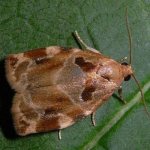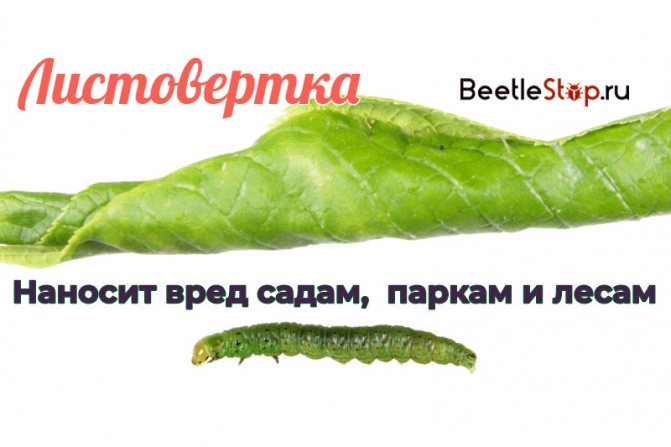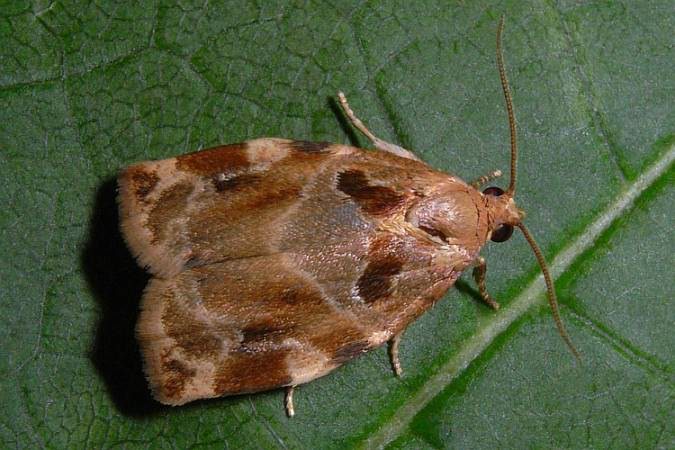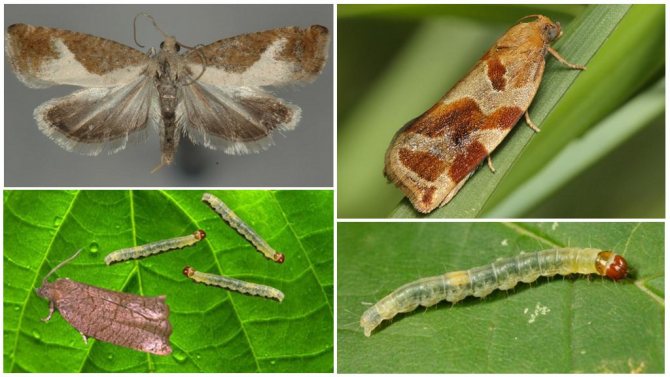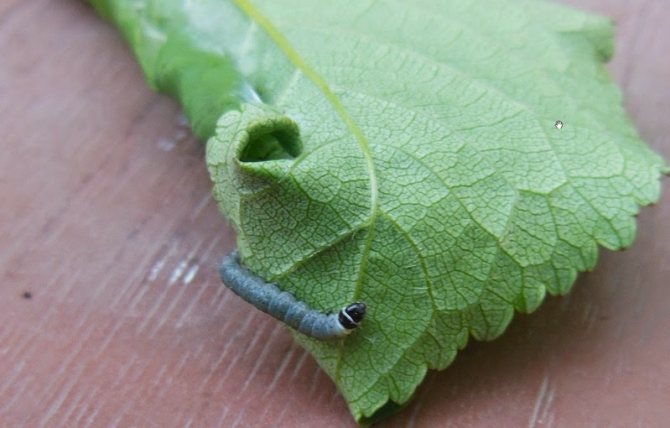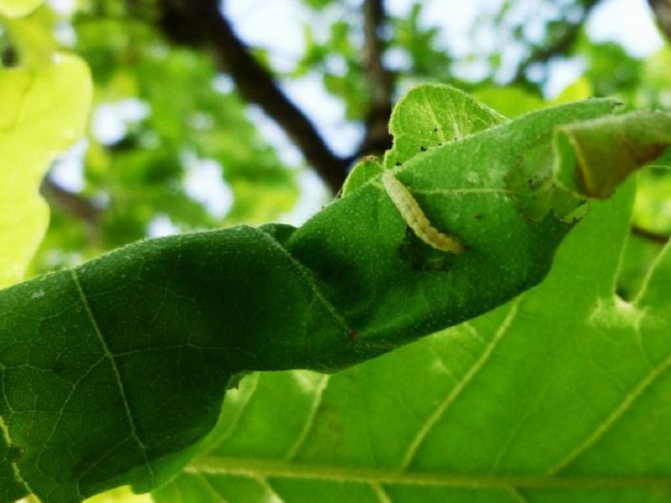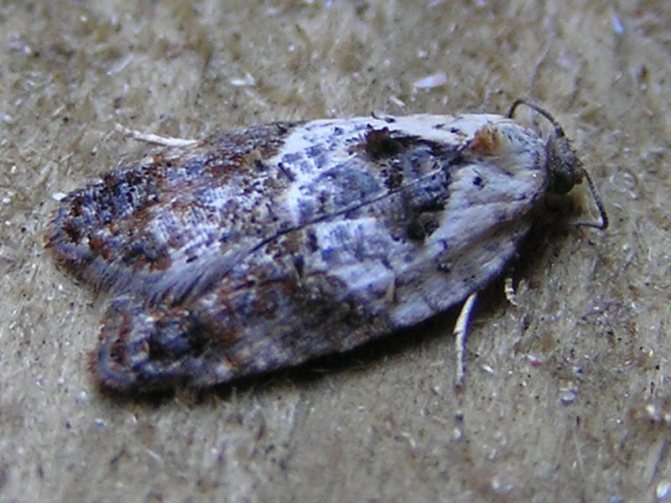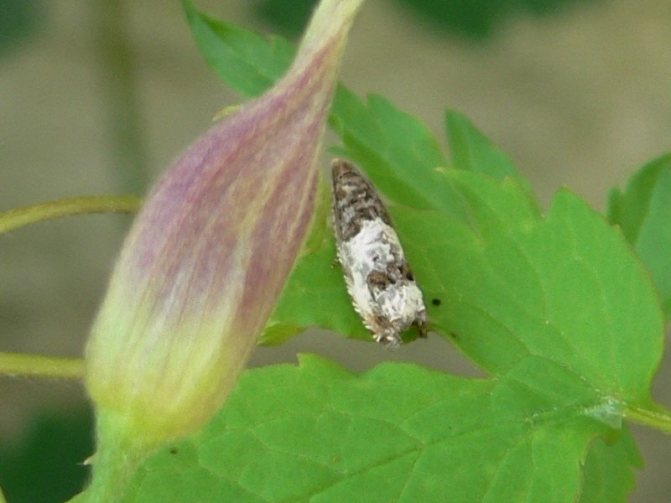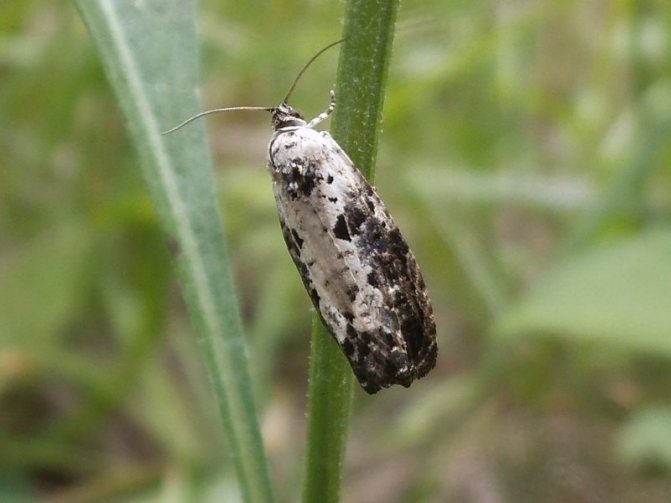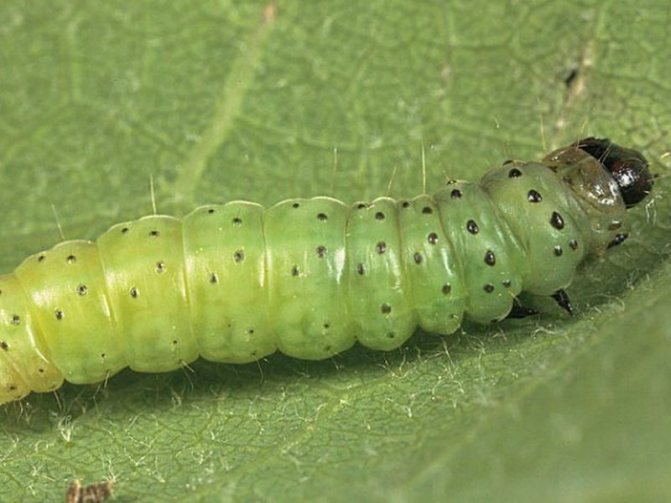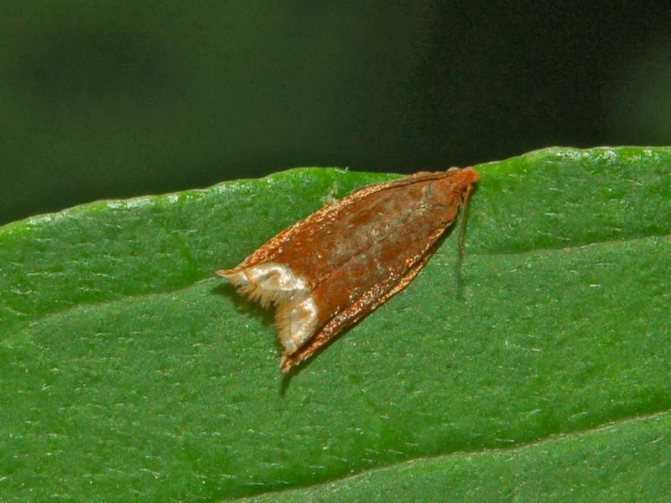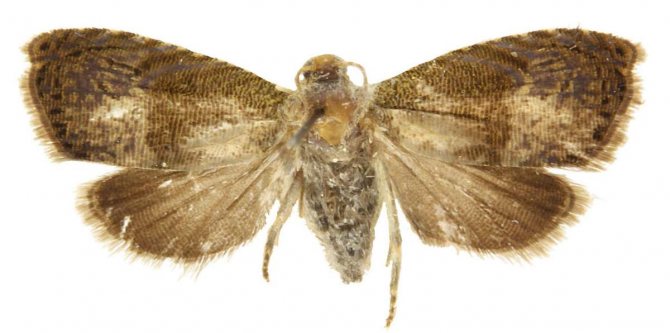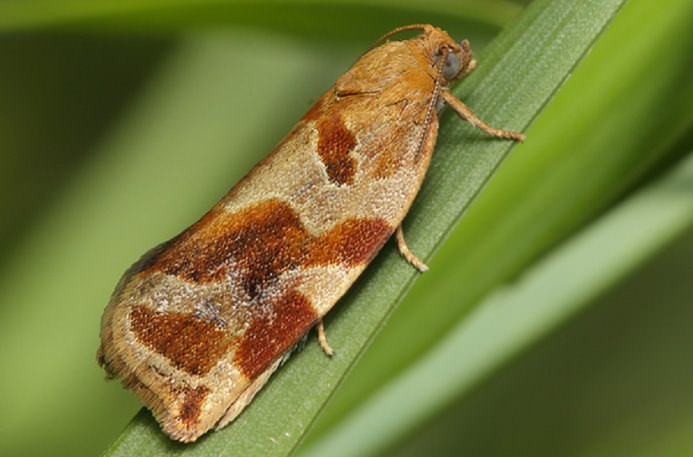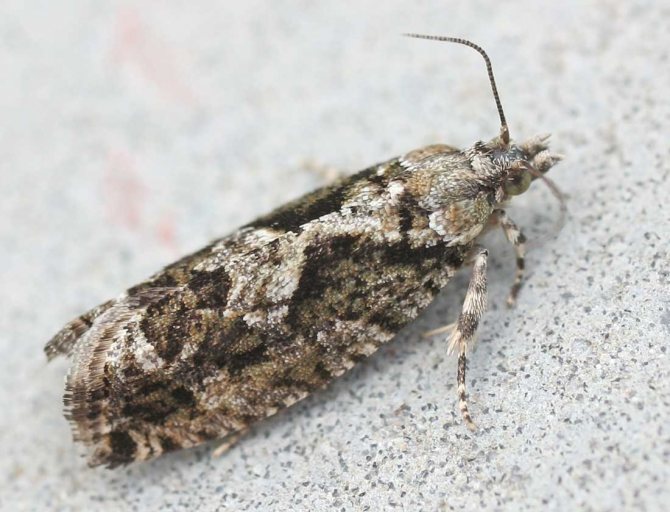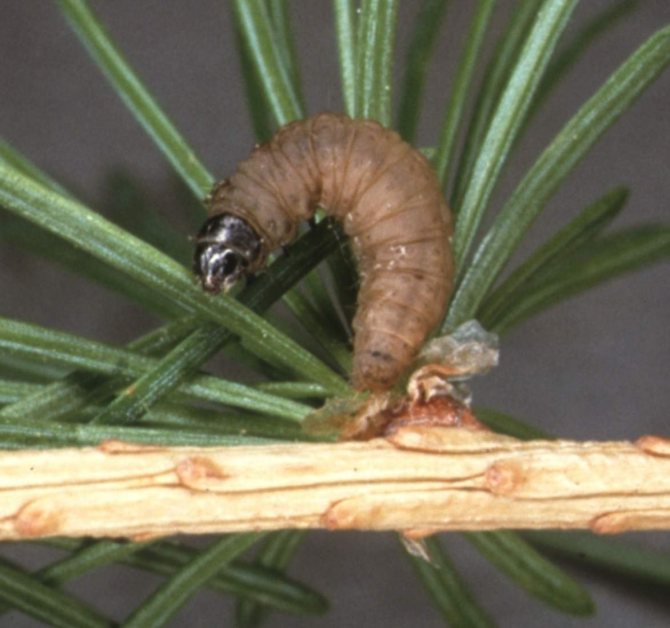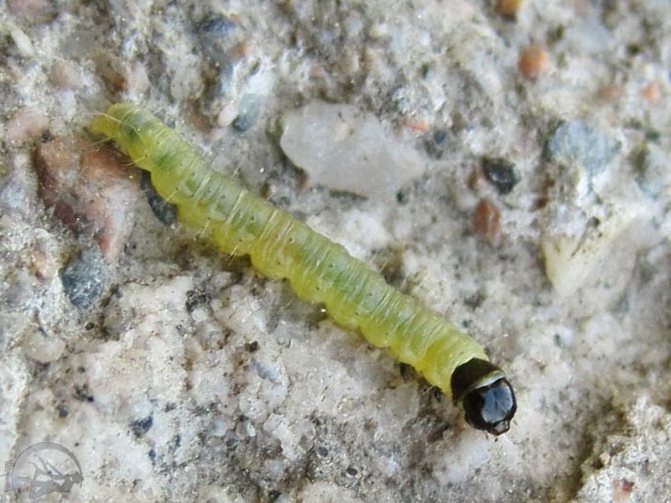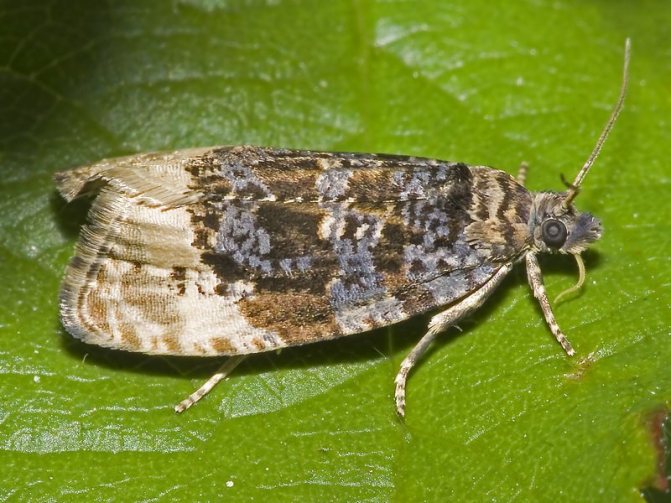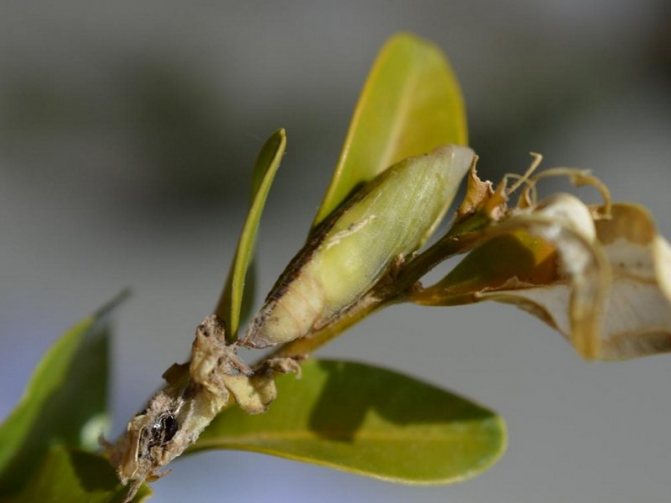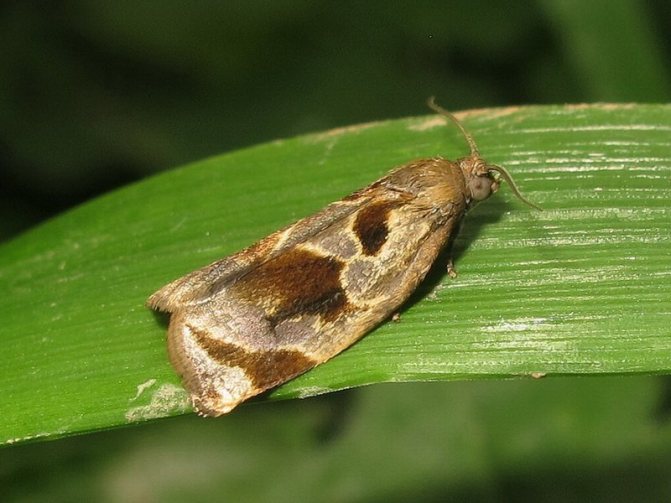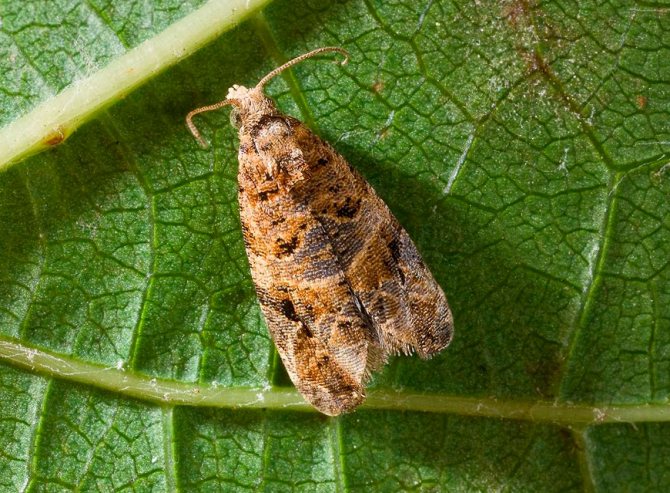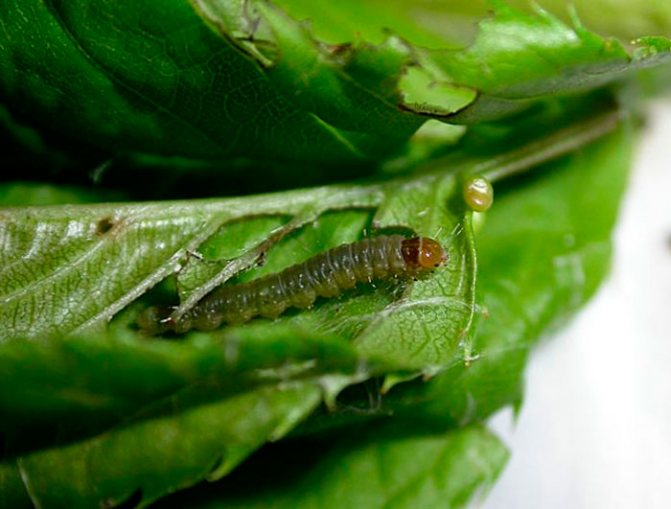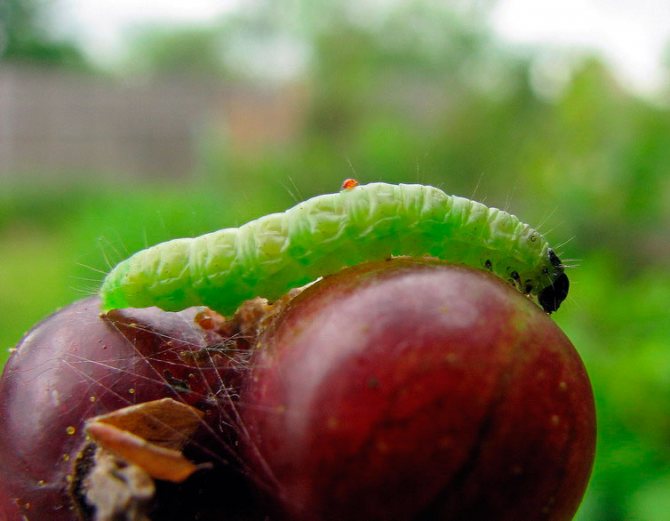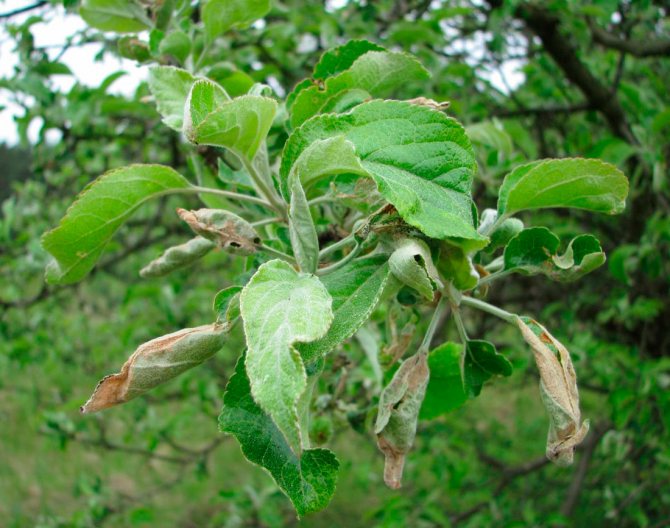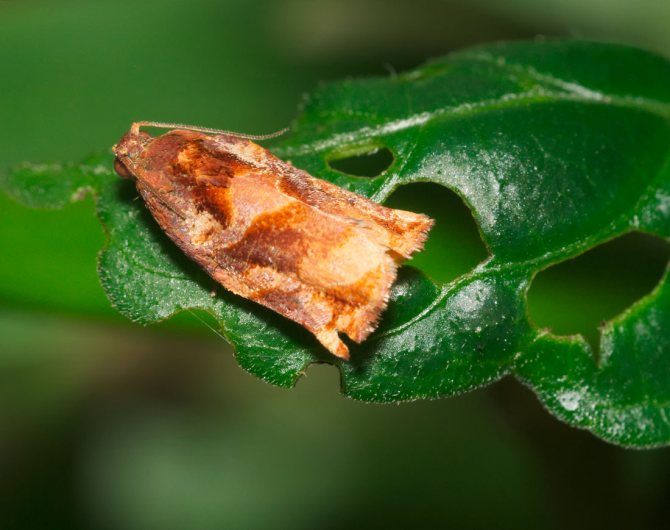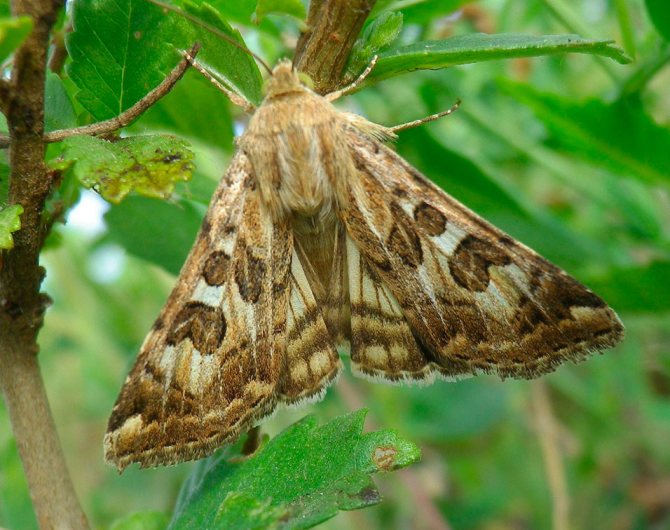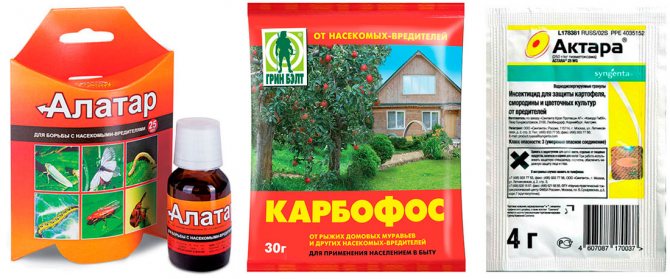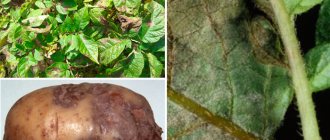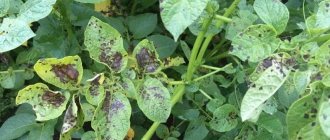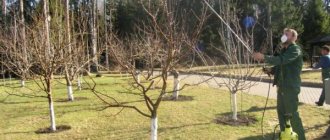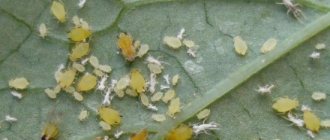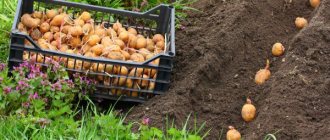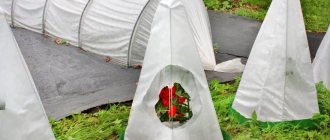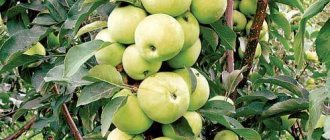In this article, we are moving into the “heavyweight league”. Here gathered those who often took the “champion belt” from gardeners and left without a crop. These "aggressors" leave plants without leaves, without color, without fruit. Remember their names: leaf rollers, flower beetles, moths and suckers. For a successful fight, learn how to make and put on time trapping belts, pheromone and light traps, and also do not be lazy and engage in systematic collection and removal of volunteers from the garden. And now let's consider each "enemy" separately ...
Pest appearance
A leaflet is little butterfly with a plump shaggy body and small wingspan, no more than 2.5 cm.
The color of the wings ranges from gray to various shades of brown, often with a distinct pattern of a darker color in the form of stripes or ornamentation.
She folds her wings not vertically, like most butterflies, but horizontally, completely covering her body with them. Butterflies fly out late in the evening and at night, and during the day they hide in shelters.
Larval caterpillars cause the greatest harm to apple trees. Caterpillars have a smooth body, the color can be yellowish, brown, greenish or brown. The head is brown or black. They feed on buds, young leaves, and some varieties reach fruits.
The life cycle depends on the type of leafworms; it differs in the timing of the appearance of caterpillars, the place of wintering, and the time of departure of butterflies.
For apple trees, leafworms are dangerous:
- Rosanna;
- Currant;
- Omnivorous;
- Fruit;
- Kidney vertebrate.
Egg clutches hibernate on branches, caterpillars - in a dense cocoon in cracks in the trunk, on shoots near buds, in dried curled leaves. The emergence of caterpillars coincides with the swelling of the buds or the beginning of flowering.
In June, they pupate in rolled leaves for 10 - 14 days, after which butterflies fly out, which make several clutches of eggs within a month. The eggs develop for about two weeks, after which new caterpillars appear, which fold the leaves with the help of a cobweb, gnaw them, and sometimes even reach the fruits.
This is what a leaf roller looks like on an apple tree - a photo of butterflies:
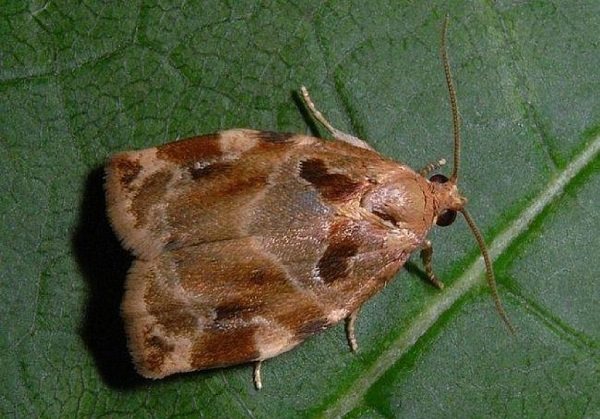
Rose leafworm.
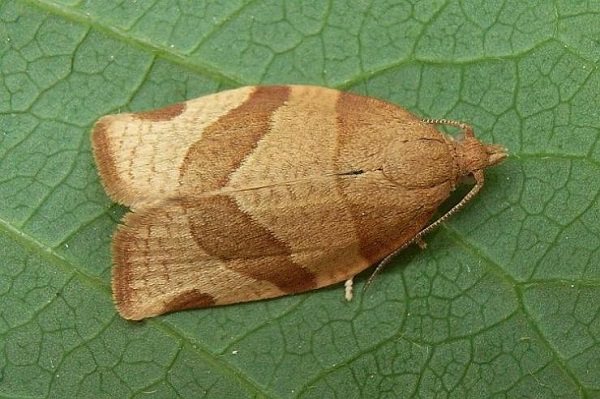

Currant leafworm.
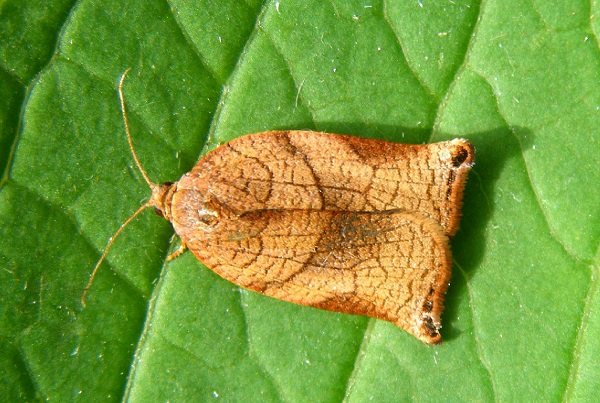

The leafworm is omnivorous.
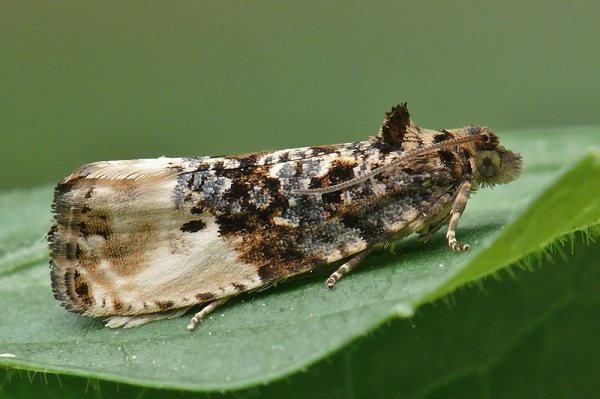

Fruit roll.


Kidney leafworm.
Features of the leaf roll
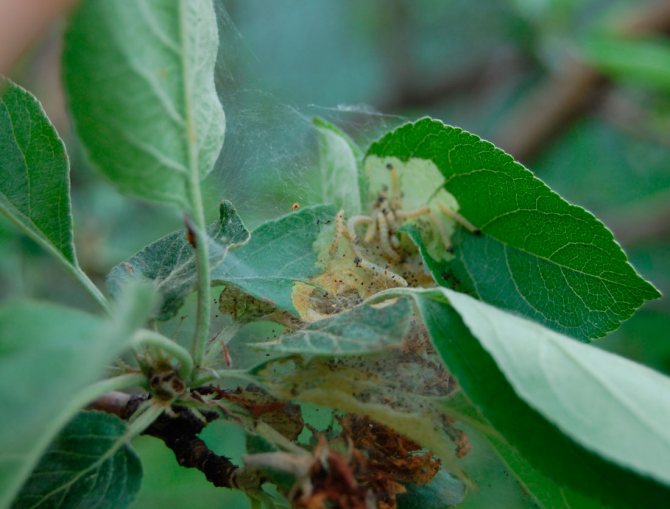

The leafworm butterfly is outwardly similar to a moth or a moth. Its wingspan does not exceed 25 mm. As a rule, her body is thick and has a dense covering, consisting of hairs. The wings fold horizontally on the back. The length of the practically naked caterpillars of these butterflies varies from 10 to 20 mm, they have 16 legs, a head of brown or black color and a pale green or light yellow body. On the belly rings, caterpillars have a belt on which hooks are located. It is the caterpillars, not the adult butterflies, that harm the plants.
In a rather large family of leaf rollers, only a couple of genera stand out best of all, namely: the shoots they devour the shoots and buds of conifers and moths - they harm garden shrubs and trees. All other pests belonging to this family damage almost all parts of various crops, both aboveground and underground (roots). Below it will be described in detail about the moth moths.
The leafworm is capable of very much harm to garden shrubs and trees, it damages the foliage of plants. Caterpillars hide in the leaves and wrap them in tubes or bundles, while pulling them together with cobwebs. Since there are a huge number of different types of leaf rollers, which have a lot of differences among themselves, in each of the sections a specific type of leaf rollers will be described that can harm a certain garden shrub or tree.
What is dangerous
The caterpillars of leafworms harm the apple tree during the entire growing season.
The first caterpillars damage flower buds, due to which the formation of fruit ovaries is reduced. After flowering, they move to the tops of young shoots, eat and fold the apical leaves, which leads to growth retardation.
This is especially dangerous for young apple trees, in which crown formation occurs. In the second half of summer, caterpillars go to fruits, eating holes in them.
During mass reproduction, leafworms move to other fruit trees and shrubs in the garden.
The most common types
More than 10 thousand species of leaf rollers are known to modern science, representatives of which can be conditionally divided into pests of berry, fruit and ornamental crops, forests and grapes. Let's consider a description of some leaf rollers of each type.
- Rose leafworm is capable of parasitizing both ornamental and berry bushes and fruit trees. Insects located in the steppe regions attack mainly stone fruits, in the forest-steppe zone and woodland - pear and apple trees. This parasite gives one generation per year, hibernates in the egg stage. The rosaceous leafworm can be recognized by the following features: an adult butterfly has a thin abdomen and a relatively small wingspan - about 1.4-2.2 cm. The front wings are presented in the form of a trapezoid, their color can vary from ocher yellow to dark brown. The shade of the hind wings is gray-brown. The larva is no more than 2 cm in size, the body is translucent, the color is variable: from light green to dark olive.
- The grape roll can damage both grapes and some other crops. It is known that this insect can parasitize on deciduous and coniferous trees, as well as on fruit and berry plants. Her diet contains: grapes, juniper, plum, blackberry, aspen, oak, pine, persimmon, tangerine, strawberry, eucalyptus, etc. Caterpillars released after wintering are harmful. They gnaw at the foliage, skeletonizing it and entangling it with cobwebs. Sometimes the larvae also damage young shoots and petioles. In one year, this insect is capable of giving two generations. Hibernates at the stage of the first instar caterpillar. The wings of a grape leafworm butterfly have an ocher-yellow or golden-green color and a grayish-brown pattern composed of spots. Sometimes spots may be indistinct or completely absent. The larva is about 1.8-2.2 cm long. The upper part of the body of the caterpillar of the grape leafworm is painted in a dirty green color, the lower one is usually lighter.
- The broom roll is another very dangerous enemy of vineyards, which is also able to successfully develop on other crops, for example, on raspberries, hawthorns, buckthorns, currants, etc. This pest affects fruits, flowers and ovaries. It reproduces very actively and in one year it can give three, sometimes four generations. Crimson leafworm butterfly is small with a wingspan of no more than 1.5 cm. The main color of the front wings is brown-brown or brown-olive, pattern: lead-gray strokes, bands and ocher-yellow spots. The hind wings are gray. The body length of the larva does not exceed 1.2 cm. Its integument is colored yellow or olive-green with a grayish tint.
Important! If you do not take steps in time to protect the grape plantings, then you can lose about 45% of the harvest, and with a large number of the parasite colony, and all 100%!
- The hawthorn leafworm damages the foliage of stone fruit, fruit and forest trees. Damages hawthorn, mountain ash, apple, cherry, pear, plum, blackthorn, linden, hazel, ash, etc. It gives one generation per year and hibernates in the egg phase. An adult is a medium-sized butterfly with a wingspan of up to 2.7 cm. The front wings are gray-brown. The dark brown pattern consists of spots and a sling. Hind wings are one-color - brown-gray. The caterpillar has dark gray or greenish-black integuments. The body length of the larva is about 2-2.3 cm.
- The spruce leaf roll develops on all types of spruce. An adult butterfly is small in size - the wingspan usually does not exceed 1.6 cm. On the front wings, painted in a gray-brown color, there is a pattern consisting of stripes of a lead shade. The hind wings are gray-brown and have a light fringe. There are clearly visible light stripes on the abdomen. The caterpillar has a yellowish-white body and a light brown head. It damages the cones and eats away the seeds that are inside them. The development of one generation of this type of insect takes from one to two years. Spruce leafworm overwinters at the caterpillar stage in damaged cones.
On a note! With a large number of insects, the number of damaged cones reaches 80%. As a result of parasitizing leaf rollers, their appearance does not change, but such cones give insignificant germination!
- The green oak leafworm is a leaf-eating parasite that damages oak. The pest can be recognized by the following features: the wingspan is from 1.8 to 2.3 cm, the color of the front ones is bright green with a thin yellow stripe, the back ones are painted gray. The body length of the caterpillar does not exceed 2 cm, the color of the integument is pale green or gray-green. It is active in the spring, due to which, by about the last decade of June, the eaten leaves have time to recover, but at the same time they lose their resistance to powdery mildew, and therefore are often damaged by it. Shoots suffer more: they do not have time to woody by winter and are exposed to frostbite.
- The fruit roll is harmful to woody and shrub plants, which are pink-flowered. These include: cherry, apple, hawthorn, pear, mountain ash, cherry plum, apricot, etc. The fruit roll butterfly is relatively small - the wingspan does not exceed 1.7-2.3 cm. The color of the front wings is brown-brown or dark gray, small white spots are located along the inner edge. The caterpillar is about 1.8-2 cm in size, the integument is dark green or gray-green.
Leaf roll on an apple tree: how to fight?
Advice! Chemical treatment is carried out if, when examining a tree, more than 5 caterpillars are found on one branch.
For protection, it is necessary to spray not only the apple tree, but also other trees and shrubs growing nearby.
Leafworm butterflies migrate and invade nearby territories.
How to treat an apple tree from a leaf roller? To combat lepidoptera, which include leafworms, are effective:
- "Avant" - affects the caterpillars at any stage of their development, processing can be carried out by laying eggs. Applied no more than 2 times per season, the interval between treatments is 14 days. Resistant to rain;
- "Decis-Profi" - the advantage of the drug in the speed of action and the absence of phytotoxicity;
- "Inta-Vir" - affects caterpillars, scares away butterflies. One tree will require 5 liters of solution, processing is carried out 25 days before harvesting. Not used as a prophylaxis;
- "Calypso" - protection up to 30 days, low toxicity for beneficial insects, addiction of pests to this drug was not noticed;
- "Kinmix" - the speed of exposure to pests is about 1 hour, it remains on the surface of leaves for a long time.
When choosing how to spray an apple tree from a leaf roll, you should take into account the growing season, the degree of pest damage to the garden, weather conditions and air temperature.
Watch the video for tips on dealing with the leaf roll:
Prevention measures


As a rule, absolutely healthy and strong plants are bypassed by pests. And first of all, leafworms settle on crops weakened by disease or inappropriate care. Remember the agrotechnical rules of crops, and also provide them with timely care, for this, the plants need to weed, water, cut and feed on time. Make sure that the crowns of plants are not overly thickened, and also that there is a sufficient amount of nutrients and moisture in the soil, but remember that both their lack and excess can harm both shrubs and trees. If the near-trunk circle is overgrown with grass, then this increases the likelihood of a leaf roll. Make sure that the soil in the trunk circle is always loose.
In order to prevent the spread of leafworm caterpillars in the garden, it is necessary to remove loose leaves and fruits from under the plants every day, especially if the moth has settled on them. In trees in early spring, the bark is cleaned, for this dead parts are removed, after which the surface of the stem is covered with milk of lime on top, which is mixed with a chalk solution or copper sulfate, and Karbofos (2%) is also added to it. Try to prevent frost damage and mechanical damage on trees.
Preventive treatments
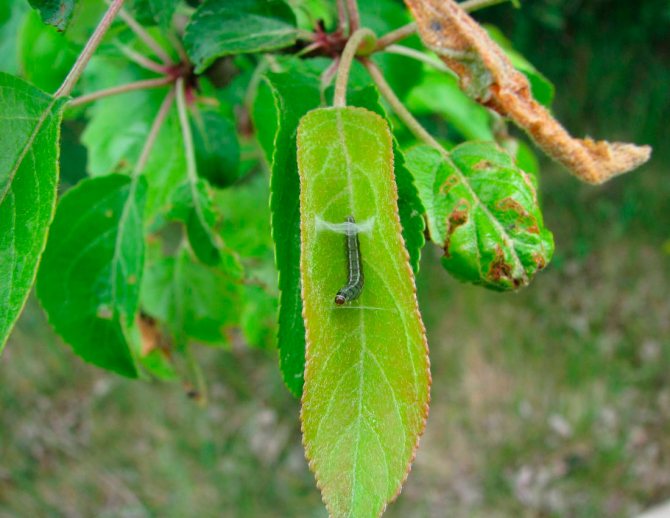

In order to prevent the appearance of leaf rollers on the garden plot, experts advise, systematically carry out preventive treatments. For the first time this season, the plants are treated in early spring, immediately after the skeletal branches and tree trunks are cleaned and whitewashed. Processing is carried out before sap flow begins, while the air temperature should be at least 10 degrees, but if it is colder outside, the larvae will hide under the bark, and the drug used for spraying will not be able to act on them.
For the purpose of prevention, plants are treated with agents such as Kinmix or Decis, and do not forget to follow the instructions. These funds are also used for subsequent treatments, which are carried out shortly before the plants bloom and immediately after flowering. During the growth of fruits, fruit shrubs and trees are also sprayed for prophylaxis, for this you can use Karbofos, Iskra, Kinmix, Fury, Kemifos, Tsitkor or Decis. After that, the crops are no longer sprayed with chemicals, but you still need to regularly remove loose fruits and leaves, pick off foliage rolled with a leaf roll from the plants, and also regularly hang traps and use trapping belts to tie trees. When leaf fall ends, clear the garden area of foliage and loosen the soil in the tree-trunk circles. Then shrubs and trees, as well as the surface of the earth under them, are sprayed with copper sulfate or Bordeaux mixture.
Processing time
In the spring, more before budding, the apple trees should be examined... If clutches of eggs are found near the buds and on the shoots, then the treatment should be carried out when the flower buds will start to turn pink.
If white cocoons are found in cracks in the bark, it means that larvae-caterpillars will appear from them. Processing from them is carried out in the green cone phase.
The green cone is the bud opening phase: they swell, burst and release the tips of the leaves. This period is very short-lived, it is important not to miss it.
If you manage to carry out processing at this time, then the first generation caterpillars will be destroyed. it will allow the apple tree to fully bloom and form ovaries.
Since leafworms migrate, they can fly from other places.In the future, you should monitor the appearance of butterflies or the first caterpillars, conducting regular inspection of the trees. The next treatment should be carried out at the first detection of pests.
IMPORTANT! It is impossible to carry out treatment during flowering, because all the recommended insecticides are dangerous for bees.
When using drugs, you should act according to instructions and take into account the air temperature. If processing is carried out at a higher, or vice versa, low temperature, the agent will not work.
What plants are affected by the pest?
Leaf rollers - pests of legumes, fruit, berry and ornamental plants... They adapt well to changes in the surrounding landscape. Leafworm caterpillars harm the most..
They eat in the gardens apple trees, plums, pears, cherries, cherries, apricots, cherry plums, honeysuckle, teren, grapes, currants, raspberries.
Caterpillars can often be seen on roses, rose hips, lilacs... They also spoil the decorative look. conifers.
Of woody deciduous plants, leaf rollers are found on willow, alder, maple, mountain ash, elm, oak, linden, birch, ash, poplar... The pest successfully develops on hawthorn, viburnum, elderberry, buckthorn, privet.
Other methods and measures
If the apple tree is affected insignificantlythen twisted leaves must be torn off... Collect them carefully, because the caterpillars, despite their apparent slowness, can quickly slip out of the leaf.
Leaves must be burned. If they are simply thrown over a plot or in a compost heap, the larva will go through the entire development cycle in a folded leaf, and then, in the form of a butterfly, will return to the apple tree again.
To combat leafworms, you should bring to the garden birds. You can hang feeders on the apple trees, into which you pour some unroasted seeds. Do not add a lot of food, because the birds will be full and will not look for caterpillars and butterflies.
They hang at a height of 1.5 meters traps. To do this, cut off the neck of a plastic bottle and attach it to the barrel.
Pour fermented as bait kvass, compote, beer, sweet tea. They are hung in the evening, and in the morning they are removed or closed to avoid beneficial insects from getting inside.
During the day, butterflies hide on the trunk of an apple tree or on branches under the leaves. Due to their color, they are almost invisible on the bark, but upon close examination they can be detected. They should be collected and destroyed.
Can be hung on the trunk trapping belts made of burlap or thick paper, and apply garden glue on them. You will need to hang several belts on one tree. The belt is hung in the spring, and removed in the fall after the foliage has fallen.
In winter helpers in pest control are tits... They are attracted to pieces of unsalted bacon. Titmouses are able to peck out most of the caterpillars from cracks in the bark.
A leaf roll in the garden is a dangerous pest of fruit trees
05/05/2017 This harmful insect got the name "leaf roll" for its ability to fold the leaves of fruit trees into tubes, braiding them with cobwebs and pulling them into bunches, which makes the leaves die.
The leafworm is a member of the Lepidoptera family (lat. Tortricidae or Olethreutidae
), which has more than ten thousand species of insects (about one hundred of which are considered to be pests).
A particular danger to the garden is represented by leafworm caterpillars, which during the growing season can cause irreparable harm to fruit trees, damaging flower buds (buds), succulent leaves and fruits. The larvae of the leafworm inflict tangible damage on young fruit trees, since they gnaw the tops of green shoots during the formation of the crown.
During mass reproduction, the caterpillar population can destroy the lion's share of the harvest, because as soon as the first ovaries appear on the trees, the caterpillars attack them, eating away the inflorescences and pedicels of the flowering garden.After the fruit trees have faded, the caterpillars switch to leaves, thus disrupting the normal process of photosynthesis, and when the fruit appears, they settle inside, making them unusable.
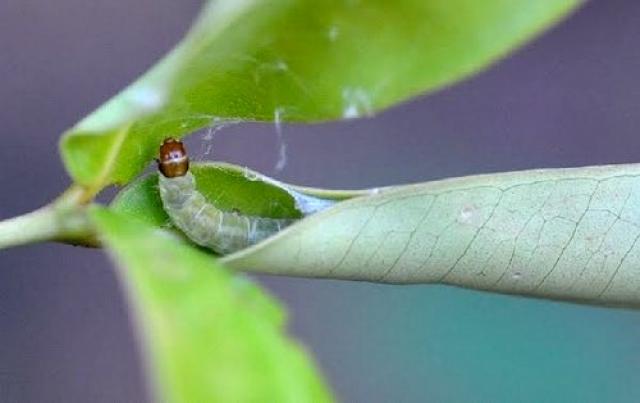

Leafworm caterpillar
The following types of leaf rollers are of particular danger to the garden:
- Omnivorous (Latin Archips podana)
- Fruit (lat.Hedya (Argyroploce)
- Rosewood (Latin Acleris bergmanniana)
- Currant (lat.Pandemis rideana)
- Kidney vertebrate (lat.spilonota ocellana)
Adult insect (imago)
In appearance, the leaf roll is a small full-bodied butterfly (from two centimeters in length) with a double body and a wingspan of over two and a half centimeters. The color of the insect's wings has a high variance, but, as a rule, varies within gray-brown and olive tones with the placement of various patterns, stripes and spots on them in the form of a variegated ornament.
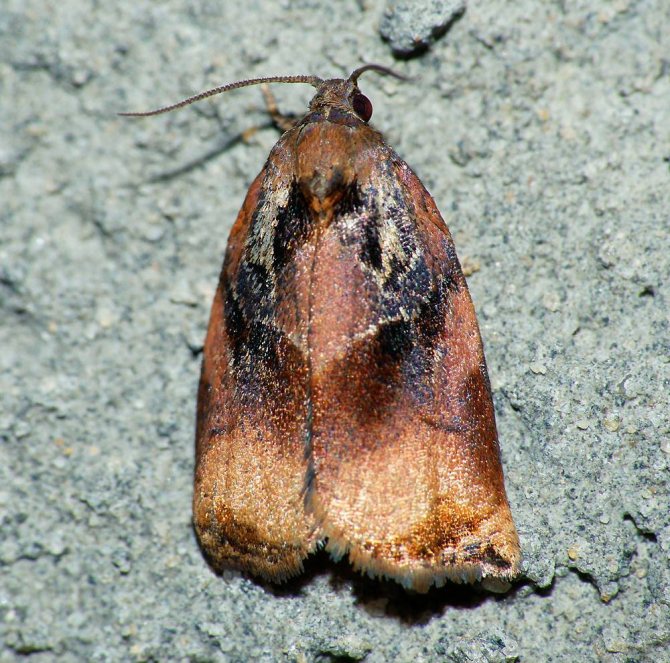

Omnivorous leafworm
The wings of a leafworm moth have either the shape of a triangle or a trapezoid and do not fold like that of most members of the family of butterflies (in the vertical plane), but lie horizontally, when folded, covering the entire body completely. The front wings are darker than the rear ones.
The leafworm butterfly leads an active nocturnal lifestyle, flying out at dusk (when the air temperature is above fifteen degrees Celsius), and during the daytime it is in a shelter (located on the trunks in or on the side branches under the leaves).
Eggs
Butterfly years begin in April - May. The female leaf roll is extremely fertile and begins the mating process as early as three days after metamorphosis and emergence from the pupa. One female is capable of laying from four hundred to eight hundred eggs per season.
Immediately after mating (on the same day), the female lays eggs, choosing fruit trees for this, which she identifies by smell.
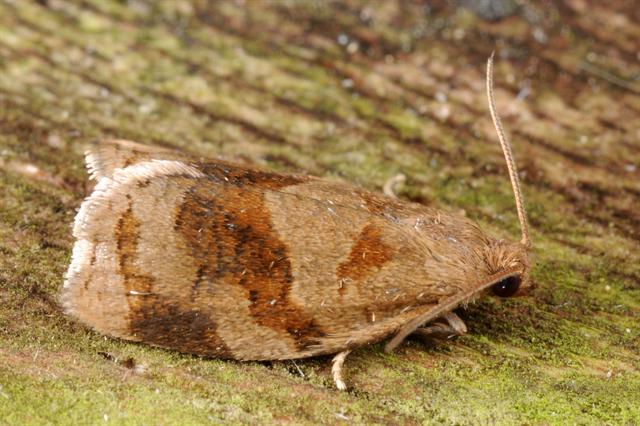

Rose leafworm
The clutch is most often a small group of eggs, which is dark in color and is located either in the forks, or in crevices and depressions in the bark, but can settle directly on ovaries, inflorescences and leaves.
Leafworm eggs hibernate on a tree.
Caterpillar
The development of the laid eggs takes about two weeks, after which voracious larvae hatch from them. The caterpillars of the leafworm have a smooth yellowish-brown or greenish body. The pest has a dark head.
The larvae feed, equipping themselves with nests in leaf rolls, which are a clear sign of the presence of a pest. If you touch the caterpillar, it will not fall to the ground, but will hang in the air not a cobweb.
Around June, the process of pupation of caterpillars takes place, which lasts about two weeks, after which an adult insect appears from the cocoon, which, having adapted, flies out, mates and immediately produces new clutches with future offspring.


Fruit roll
Caterpillars of the second generation, born at the end of summer, hibernate in a tightly knit cocoon. The cocoon can be found in folded leaves, in the depressions of branches, or at the forks of branches of fruit trees.
In early spring, the larvae wake up and move closer to the swelling young buds, after which they produce a thin spider thread, thanks to which they bind the leaves, forming a shelter (nest), in which they continue to feed and develop.
Pest control
Under favorable conditions, the pest manages to give two generations.
The first generation of insects can infect up to thirty percent of the leaves in the garden, which is a dangerous threshold of harmfulness, since it significantly reduces the quality and quantity of the crop.
If the leaves of a fruit tree are damaged by more than fifty percent, urgent control measures must be taken, because this factor is an indicator that the second offspring of the pest is growing and rapidly developing in the garden.
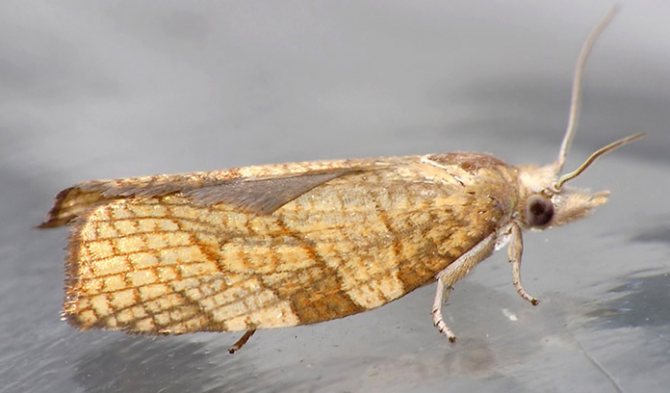

Currant leafworm
To avoid more serious damage, fruit trees should be treated with insecticides (it is advisable to use systemic drugs capable of destroying caterpillars and egg-laying of leaf rollers), since the second generation of leaf rollers larvae destroys not only leaves, but also affects fruits of garden trees.
In any case, in order not to lose the entire crop, gardeners need to regularly inspect trees in the garden for the presence of folded leaves and nests of leafworm larvae.
Chemical treatment must be carried out if more than five pest caterpillars are found on one branch.
Pest control chemicals
Insecticides must be used throughout the entire growing season of garden plants, but it is important not to forget that the duration of exposure to chemicals is strongly influenced by ultraviolet rays, which reduce the duration of the effective action of drugs.
The drug shows a high result in the fight against harmful caterpillars "Dimilin
", Which has a strong contact and intestinal effect on insects. The duration of the drug is approximately one and a half months. The chemical has low toxicity and does not harm humans, beneficial pollinating insects and other warm-blooded animals.


Leafworm Kidney Vertunya
Another effective broad-spectrum drug is called "Ditox
". It is produced in the form of a concentrated emulsion and also has a strong contact and intestinal effect on leaf rollers. An environmentally friendly chemical, which, importantly, after the treatment of trees is not washed off by precipitation, and the pests die en masse within three hours after spraying.
The next systemic drug that has earned trust among experienced gardeners is the systemic insecticide "Calypso
», Which also affects sucking and gnawing insects. The chemical is environmentally friendly for both humans and warm-blooded animals. Safe for bees and other beneficial pollinating insects. "
Calypso
"Is not addictive, which is an important factor.
Another effective and environmentally friendly insecticide is a systemic drug "Fastak
”That infects insects at various stages of their development. Shows good resistance to high temperatures. Does not wash away with rain.
Among other insecticides, the drug “Avant
", Produced in the form of a concentrated suspension. The chemical has an intestinal effect on insects and has shown good results at all stages of caterpillar development. It is effective even in the processing of egg-laying moths, because it kills the larvae at the moment when they hatch from the egg. The drug can withstand high air temperatures and is not washed off by precipitation. It is safe for people, animals and bees, however, it is not recommended to carry out the treatment more often than twice a season. Allows you to process trees throughout the growing season, including the period of fruiting.
Another effective biological preparation in the form of a concentrated emulsion is called "Fitoverm
". The chemical is valuable because it can also be used in any phase of tree development, up to fruiting. And what is important, at high air temperatures, the drug increases the effectiveness of its action.
It is important to remember that before treating the garden with insecticides, you must first read the instructions, strictly follow the recommendations given in it and in no case exceed the chemical consumption rates.
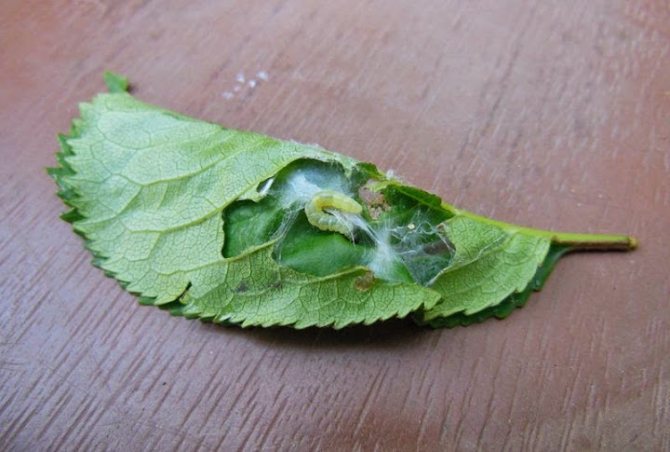

Leafworm nest
It is necessary to spray trees with insecticides completely (from bottom to top), especially during the mass summer of moths, and do not forget to process all other trees and shrubs growing nearby.
The choice of a preparation for the treatment of an orchard should take into account the period of its growing season, it is imperative to assess the degree of damage to trees, pay attention to weather conditions and air temperature.
Other types of pest control
If a leafworm (butterflies and caterpillars) appears en masse in the garden, a thorough cleaning of leaves under the trees will be a good preventive measure, which will certainly lead to the destruction of all kinds of hibernating larvae, pupae and butterflies. The collected leaves must be burned, and the soil under the tree-trunk circles must be dug up, removing all weeds.
If the trees are slightly affected by the pest, then the twisted leaves must be cut off, and the larvae must be destroyed (it is better to burn). If the damaged leaves are simply thrown away (for example, taken out of the garden or put into a compost pit), then the larva will go through the full development cycle in the nest and return to the garden already in the form of a butterfly, in order to lay down a new portion of eggs to give life to a new generation of pests.
In winter, it is recommended to clean off dead bark, moss and lichens from trees, as they may contain the pest's egg-laying. Eggs deprived of shelter are likely to freeze and not survive.
It is also helpful to cut out any dry and diseased branches and make sure that the crown of the trees is not too thick.
In the spring, it is useful to treat tree trunks with whitewash (lime milk or special garden paint), which will prevent the survival of pests located in the grooves of the bark of the trunk and under it.


Whitewashing of fruit trees
Of the folk methods of fighting the leafworm, trees are treated with infusions and decoctions of tobacco or makhorka, as well as chamomile and wormwood.
It is useful to lure birds into the garden to fight insects. To do this, it is necessary to arrange feeders in the garden, but do not pour a lot of food, otherwise the birds will get fed up and stop collecting insects.
In winter, titmouses will be an excellent help in the fight against the pest, so they need to be attracted by hanging unsalted pieces of bacon on tree branches.
It is useful to arrange trapping belts made of various materials against crawling insects.
Folk remedies
IMPORTANT! Folk remedies help only if the invasion of pests is small.
Treatment with a decoction of wormwood, potato tops or tomato leaves frightens off
butterflies... To prepare the broth:
- The bucket is filled with chopped greens by 1/3, filled with water and boiled for half an hour;
- Let it brew for 3-4 hours;
- Filter;
- Dilute with water to a volume of 10 liters;
- Add half a glass of thick liquid soap;
- Spray with this solution.
Processing is carried out in the morning or evening, when there is no wind and rain is not expected.
From caterpillars helps the infusion of tobacco. For this:
- 500 grams of tobacco dust is poured into a bucket of boiling water;
- Insist 2-3 days;
- Filter;
- Water is added twice as much as the original volume after straining;
- For stickiness, pour in a little liquid soap.
The solution is not stored, processing is carried out immediately after preparation.
Signs of damage to the apple tree
In order for the battle with the pest to be crowned with success, it is important to be able to identify signs of damage to plants already in the early stages, as well as to know the stages of development.
| Season | Stage of development | Signs of defeat |
| Early spring - late May | Caterpillars get out of hiding after winter | Cobwebs and eaten areas appear on young leaves, inflorescences, buds |
| Early summer - mid-July | Caterpillars enter the cocoon stage. They rest in the foliage, under the bark, in the envelopes of leaves there are spider nests | Cobweb in the trees |
| End of July - mid-August | Butterflies hatch from cocoons | The presence of a cobweb, the flight of butterflies |
| Late August - mid September | Females lay eggs | On the leaves, a dark-colored egg-laying is visible, covered with a wet film. |
| End of September - beginning of October | The next generation of caterpillars arrives | Eaten and shriveled leaves. Spider web on fruits and branches |
| End of october | Caterpillars find shelter in bark or soil to survive winter | |
Preventive treatment
In order to damage to reduce apple trees by pests to a minimum, you need to monitor the hygiene of the garden:
- All fallen leaves and fruits must be collected in a timely manner, cut out dry and diseased branches, loosened the soil and remove weeds;
- The crown of the apple tree should not be thickened. A thinned crown is not only important for the fruiting of an apple tree, but also for the prevention of diseases and pests;
- In the fall, after the leaves have fallen off, the trunks must be cleaned with a stiff brush from peeling pieces of bark, all egg clutches, moss and lichens must be cleaned off;
- In autumn, the trunks are treated with a thick solution of lime or special garden paint.


Cleaning the apple tree trunk with a brush.
The need to fight the leaf roll
Due to the short development period, several generations of pests can appear during the season. Each adult is capable of laying 150 eggs in a clutch; butterflies begin to mate on the third day after leaving the pupa. Therefore, having favorable conditions for life and reproduction, they are able to destroy the entire crop and cause enormous damage to the garden.
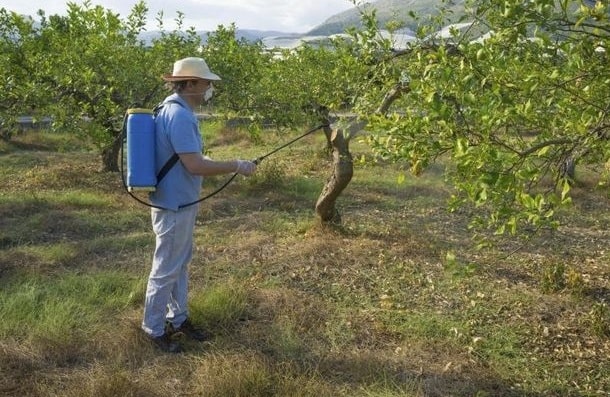

Getting rid of the leaf roll.
By refusing to fight, the gardener risks losing both the apple harvest and the harvest of other crops, because these gluttonous insects are picky about food.
Useful Tips
When looking at the garden first of all should to pay attention young shoots and leaves on the tops of branches.
Fresh herbs are the most tasty morsel for caterpillars. Any curled leaf must be cut off and destroyed.
Do not use insecticides during flowering and 25 days before harvest. All of the above agents belong to the 3rd class of toxicity for humans and remain in the fruit for a long time.
In warm and humid weather, control over apple trees should be strengthened. At this time, caterpillars become very voracious, and butterflies are active.
What does an infected plant look like?
A clear sign of damage is the curling of the leaves into a tube and the appearance of a white web... Caterpillars hide in the folded leaves. They are mobile, if you break their nest, then they begin to quickly move back, and when they slide off the sheet, they hang on the cobweb.
Caterpillars have an excellent appetite and can destroy up to 80% of green mass... They do not stop there and are taken for the rest of the plant. They gnaw holes in young shoots, buds, ovaries, fruits, destroy seeds... If the pest is not eliminated, then the crop losses will be significant.

